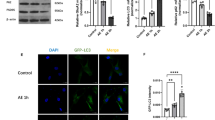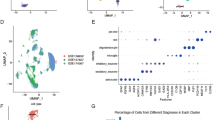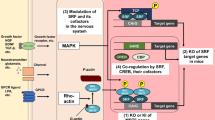Abstract
Uranium (U) is the heaviest naturally occurring element ubiquitously present in the Earth’s crust. Human exposure to low levels of U is, therefore, unavoidable. Recently, several studies have clearly pointed out that the brain is a sensitive target for U, but the mechanisms leading to the observed neurological alterations are not fully known. To deepen our knowledge of the biochemical disturbances resulting from U(VI) toxicity in neuronal cells, two complementary strategies were set up to identify the proteins that selectively bind U(VI) in human dopaminergic SH-SY5Y cells. The first strategy relies on the selective capture of proteins capable of binding U(VI), using immobilized metal affinity chromatography, and starting from lysates of cells grown in a U(VI)-free medium. The second strategy is based on the separation of U-enriched protein fractions by size-exclusion chromatography, starting from lysates of U(VI)-exposed cells. High-resolution mass spectrometry helped us to highlight 269 common proteins identified as the urano-proteome. They were further analyzed to characterize their cellular localization and biological functions. Four canonical pathways, related to the protein ubiquitination system, gluconeogenesis, glycolysis, and the actin cytoskeleton proteins, were particularly emphasized due to their high content of U(VI)-bound proteins. A semi-quantification was performed to concentrate on the ten most abundant proteins, whose physico-chemical characteristics were studied in particular depth. The selective interaction of U(VI) with these proteins is an initial element of proof of the possible metabolic effects of U(VI) on neuronal cells at the molecular level.





Similar content being viewed by others
References
Alkam D, Feldman EZ, Singh A, Kiaei M (2017) Profilin1 biology and its mutation, actin(g) in disease. Cell Mol Life Sci 74:967–981. https://doi.org/10.1007/s00018-016-2372-1
Aryal BP, Paunesku T, Woloschak GE, He C, Jensen MP (2012) A proteomic approach to identification of plutonium-binding proteins in mammalian cells. J Proteom 75:1505–1514. https://doi.org/10.1016/j.jprot.2011.11.023
ATSDR (2013) Toxicological profile for uranium U.S. Department of Health and Human Services. https://www.atsdr.cdc.gov/toxprofiles/tp.asp?id=440&tid=77. Accessed 12 Dec 2018
Bairoch A (2019) Release notes for UniProtKB/Swiss-Prot release 2013_04–April 2013. https://web.expasy.org/protscale/pscale/A.A.Swiss-Prot.html. Accessed 24 Jan 2019
Banday AA, Priyamvada S, Farooq N, Yusufi AN, Khan F (2008) Effect of uranyl nitrate on enzymes of carbohydrate metabolism and brush border membrane in different kidney tissues. Food Chem Toxicol 46:2080–2088. https://doi.org/10.1016/j.fct.2008.01.048
Barber DS et al (2007) Neurological effects of acute uranium exposure with and without stress. Neurotoxicology 28:1110–1119. https://doi.org/10.1016/j.neuro.2007.05.014
Basset C, Dedieu A, Guerin P, Quemeneur E, Meyer D, Vidaud C (2008) Specific capture of uranyl protein targets by metal affinity chromatography. J Chromatogr A 1185:233–240. https://doi.org/10.1016/j.chroma.2008.01.081
Bensoussan H et al (2009) Heavy metal uranium affects the brain cholinergic system in rat following sub-chronic and chronic exposure. Toxicology 261:59–67. https://doi.org/10.1016/j.tox.2009.04.054
Bernstein BW, Bamburg JR (2010) ADF/cofilin: a functional node in cell biology. Trends Cell Biol 20:187–195. https://doi.org/10.1016/j.tcb.2010.01.001
Betapudi V (2010) Myosin II motor proteins with different functions determine the fate of lamellipodia extension during cell spreading. PLoS One 5:e8560–e8560. https://doi.org/10.1371/journal.pone.0008560
Bishop DP, Hare DJ, Clases D, Doble PA (2018) Applications of liquid chromatography-inductively coupled plasma-mass spectrometry in the biosciences: a tutorial review and recent developments Trac-Trend. Anal Chem 104:11–21. https://doi.org/10.1016/j.trac.2017.09.017
Bussy C, Lestaevel P, Dhieux B, Amourette C, Paquet F, Gourmelon P, Houpert P (2006) Chronic ingestion of uranyl nitrate perturbs acetylcholinesterase activity and monoamine metabolism in male rat brain. Neurotoxicology 27:245–252. https://doi.org/10.1016/j.neuro.2005.11.003
Carmona A et al (2018) Uranium exposure of human dopaminergic cells results in low cytotoxicity, accumulation within sub-cytoplasmic regions, and down regulation of MAO-B. Neurotoxicology 68:177–188. https://doi.org/10.1016/j.neuro.2018.07.019
Chaudhury A, Chander P, Howe PH (2010) Heterogeneous nuclear ribonucleoproteins (hnRNPs) in cellular processes: focus on hnRNP E1’s multifunctional regulatory roles. RNA 16:1449–1462. https://doi.org/10.1261/rna.2254110
Dedieu A, Berenguer F, Basset C, Prat O, Quemeneur E, Pible O, Vidaud C (2009) Identification of uranyl binding proteins from human kidney-2 cell extracts by immobilized uranyl affinity chromatography and mass spectrometry. J Chromatogr A 1216:5365–5376. https://doi.org/10.1016/j.chroma.2009.05.023
Dinocourt C, Legrand M, Dublineau I, Lestaevel P (2015) The neurotoxicology of uranium. Toxicology 337:58–71. https://doi.org/10.1016/j.tox.2015.08.004
Eb-Levadoux Y, Frelon S, Simon O, Arnaudguilhem C, Lobinski R, Mounicou S (2017) In vivo identification of potential uranium protein targets in zebrafish ovaries after chronic waterborne exposure. Metallomics 9:525–534. https://doi.org/10.1039/c6mt00291a
Fletcher DA, Mullins RD (2010) Cell mechanics and the cytoskeleton. Nature 463:485–492. https://doi.org/10.1038/nature08908
Freedman RB et al (2017) ‘Something in the way she moves’: the functional significance of flexibility in the multiple roles of protein disulfide isomerase (PDI). Biochim Biophys Acta Proteins Proteom 1865:1383–1394. https://doi.org/10.1016/j.bbapap.2017.08.014
Han Siew P, Tang Yue H, Smith R (2010) Functional diversity of the hnRNPs: past, present and perspectives. Biochem J 430:379–392. https://doi.org/10.1042/bj20100396
Konietzny A, Bar J, Mikhaylova M (2017) Dendritic actin cytoskeleton: structure. Funct Regul Front Cell Neurosci 11:147. https://doi.org/10.3389/fncel.2017.00147
Le Clainche C, Dwivedi SP, Didry D, Carlier M-F (2010) Vinculin is a dually regulated actin filament barbed end-capping and side-binding protein. J Biol Chem 285:23420–23432. https://doi.org/10.1074/jbc.M110.102830
Lothian A, Hare DJ, Grimm R, Ryan TM, Masters CL, Roberts BR (2013) Metalloproteomics: principles, challenges, and applications to neurodegeneration. Front Aging Neurosci. https://doi.org/10.3389/fnagi.2013.00035
Malard V, Prat O, Darrouzet E, Berenguer F, Sage N, Quemeneur E (2005) Proteomic analysis of the response of human lung cells to uranium. Proteomics 5:4568–4580
McDiarmid MA et al (2000) Health effects of depleted uranium on exposed Gulf War veterans. Environ Res 82:168–180. https://doi.org/10.1006/enrs.1999.4012
Mergenthaler P, Lindauer U, Dienel GA, Meisel A (2013) Sugar for the brain: the role of glucose in physiological and pathological brain function. Trends Neurosci 36:587–597. https://doi.org/10.1016/j.tins.2013.07.001
Michalke B, Willkommen D, Drobyshev E, Solovyev N (2018) The importance of speciation analysis in neurodegeneration research Trac-Trend. Anal Chem 104:160–170. https://doi.org/10.1016/j.trac.2017.08.008
Paredes E et al (2016) Evidence of isotopic fractionation of natural uranium in cultured human cells. Proc Natl Acad Sci USA 113:14007–14012. https://doi.org/10.1073/pnas.1610885113
Paredes E et al (2018) A new procedure for high precision isotope ratio determinations of U, Cu and Zn at nanogram levels in cultured human cells: what are the limiting factors? Talanta 178:894–904. https://doi.org/10.1016/j.talanta.2017.10.046
Pible O, Guilbaud P, Pellequer JL, Vidaud C, Quemeneur E (2006) Structural insights into protein-uranyl interaction: towards an in silico detection method. Biochimie 88:1631–1638. https://doi.org/10.1016/j.biochi.2006.05.015
Pollard TD (2016) Actin and actin-binding proteins. Cold Spring Harb Perspect Biol 8:5. https://doi.org/10.1101/cshperspect.a018226
Porath J, Carlsson J, Olsson I, Belfrage G (1975) Metal chelate affinity chromatography, a new approach to protein fractionation. Nature 258:598–599
Prat O, Berenguer F, Malard V, Tavan E, Sage N, Steinmetz G, Quemeneur E (2005) Transcriptomic and proteomic responses of human renal HEK293 cells to uranium toxicity. Proteomics 5:297–306. https://doi.org/10.1002/pmic.200490085
Presgraves SP, Ahmed T, Borwege S, Joyce JN (2004) Terminally differentiated SH-SY5Y cells provide a model system for studying neuroprotective effects of dopamine agonists. Neurotox Res 5:579–598
Razinia Z, Mäkelä T, Ylänne J, Calderwood DA (2012) Filamins in mechanosensing and signaling. Ann Rev Biophys 41:227–246. https://doi.org/10.1146/annurev-biophys-050511-102252
Renault S, Faiz H, Gadet R, Ferrier B, Martin G, Baverel G, Conjard-Duplany A (2010) Uranyl nitrate inhibits lactate gluconeogenesis in isolated human and mouse renal proximal tubules: a 13C-NMR study. Toxicol Appl Pharmacol 242:9–17. https://doi.org/10.1016/j.taap.2009.09.002
Schmidpeter PA, Schmid FX (2015) Prolyl isomerization and its catalysis in protein folding and protein function. J Mol Biol 427:1609–1631. https://doi.org/10.1016/j.jmb.2015.01.023
Schmitz HD, Bereiter-Hahn J (2002) Glyceraldehyde-3-phosphate dehydrogenase associates with actin filaments in serum deprived NIH 3T3 cells only. Cell Biol Int 26:155–164. https://doi.org/10.1006/cbir.2001.0819
Schonbrunner ER, Schmid FX (1992) Peptidyl-prolyl cis-trans isomerase improves the efficiency of protein disulfide isomerase as a catalyst of protein folding. Proc Natl Acad Sci USA 89:4510–4513. https://doi.org/10.1073/pnas.89.10.4510
Shaki F, Hosseini MJ, Ghazi-Khansari M, Pourahmad J (2013) Depleted uranium induces disruption of energy homeostasis and oxidative stress in isolated rat brain mitochondria. Metallomics 5:736–744. https://doi.org/10.1039/c3mt00019b
Szpunar J, Lobinski R (2002) Multidimensional approaches in biochemical speciation analysis. Anal Bioanal Chem 373:404–411. https://doi.org/10.1007/s00216-002-1282-2
Tai H-C, Besche H, Goldberg A, Schuman E (2010) Characterization of the brain 26S proteasome and its interacting proteins. Front Mol Neurosci. https://doi.org/10.3389/fnmol.2010.00012
Templeton DM, Fujishiro H (2017) Terminology of elemental speciation—an IUPAC perspective Coordin. Chem Rev 352:424–431. https://doi.org/10.1016/j.ccr.2017.02.002
UNSCEAR (2017) Sources, effects and risks of ionizing radiation. United Nations. http://www.unscear.org/unscear/en/publications/2016.html. Accessed 12 Dec 2018
Zybailov B, Mosley AL, Sardiu ME, Coleman MK, Florens L, Washburn MP (2006) Statistical analysis of membrane proteome expression changes in Saccharomyces cerevisiae. J Proteome Res 5:2339–2347. https://doi.org/10.1021/pr060161n
Acknowledgements
We acknowledge the Transversal Toxicology Program run by the Direction de la Recherche Fondamentale (DRF) of the Commissariat à l’énergie atomique et aux énergies alternatives (CEA) and the financial support from this program. E.P. also thanks the CEA Enhanced Eurotalents program, co-funded by the European Commission through the Marie Sklodowska-Curie COFUND program under the 7th Framework Program for Research and Technological Development. This work was also partially funded by the CNRS Interdisciplinary Mission through the PEPS (Projet Exploratoire Premier Soutien) Faidora program (Faibles Doses, Risques, Alertes). We acknowledge the Li2D laboratory for its technical support.
Author information
Authors and Affiliations
Corresponding authors
Ethics declarations
Conflict of interest
The authors declare that they have no conflict of interest.
Additional information
Publisher's Note
Springer Nature remains neutral with regard to jurisdictional claims in published maps and institutional affiliations.
Electronic supplementary material
Below is the link to the electronic supplementary material.
Rights and permissions
About this article
Cite this article
Vidaud, C., Robert, M., Paredes, E. et al. Deciphering the uranium target proteins in human dopaminergic SH-SY5Y cells. Arch Toxicol 93, 2141–2154 (2019). https://doi.org/10.1007/s00204-019-02497-4
Received:
Accepted:
Published:
Issue Date:
DOI: https://doi.org/10.1007/s00204-019-02497-4




